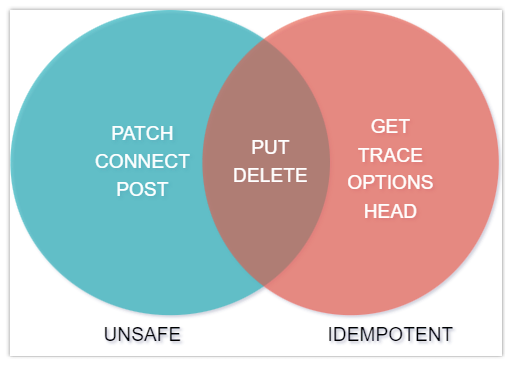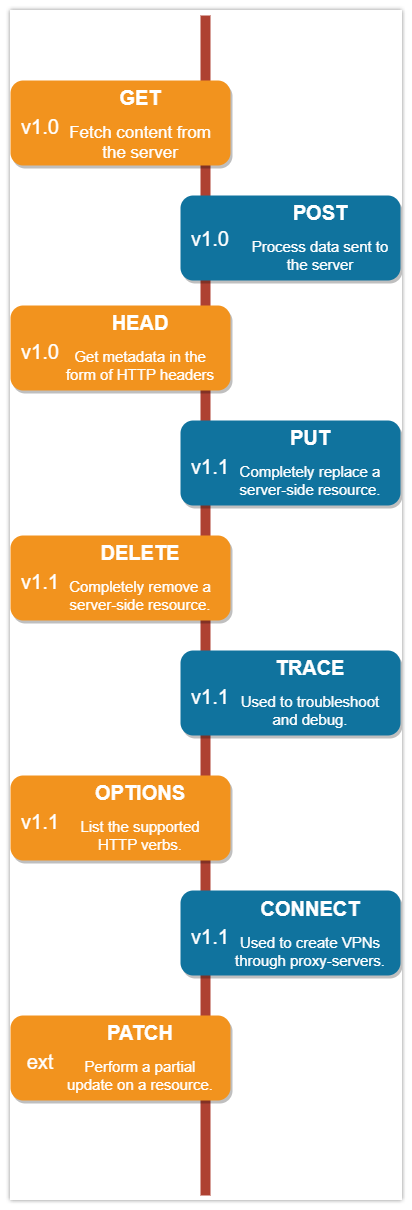HTTP request methods explained
HTTP request methods
These are the nine HTTP methods typically associated with RESTful web development and the Hypertext Transfer Protocol and most commonly used by RESTful API designers:
- GET.
- PUT.
- POST.
- DELETE.
- PATCH.
- HEAD.
- OPTIONS.
- TRACE.
- CONNECT.
Purpose of each HTTP method
The 1.0 version of the Hypertext Transfer Protocol, issued way back in 1996, only defined three HTTP verbs: GET, POST and HEAD.
GET
The most commonly used HTTP method is GET.
The purpose of the GET method is to simply retrieve data from the server. The GET method is used to request any of the following resources:
- A webpage or HTML file.
- An image or video.
- A JSON document.
- A CSS file or JavaScript file.
- An XML file.
The GET request method is said to be a safe operation, which means it should not change the state of any resource on the server.
POST
The POST HTTP request method sends data to the server for processing.
The data sent to the server is typically in the following form:
- Input fields from online forms.
- XML or JSON data.
- Text data from query parameters.
The HTTP specification enables the developer to decide the type of processing for the data sent through an HTTP POST method. Prototypical uses of the POST method include the following:
- Post a message to a bulletin board.
- Save data from HTML forms to a database.
- Calculate a result based on data submitted.
A POST operation is not considered a safe operation, as it has the power to update the state of the server and cause potential side effects to the server’s state when executed.
The HTTP POST method is not required to be idempotent either, which means it can leave data and resources on the server in a different state each time it is invoked.
HEAD
The HTTP HEAD method simply returns metadata about a resource on the server. This HTTP request method returns all of the headers associated with a resource at a given URL, but does not actually return the resource.
The HTTP HEAD method is commonly used to check the following conditions:
- The size of a resource on the server.
- If a resource exists on the server or not.
- The last-modified date of a resource.
- Validity of a cached resource on the server.
The following example shows sample data returned from a HEAD request:
HTTP/1.1 200 OK Date: Fri, 19 Aug 2023 12:00:00 GMT Content-Type: text/html Content-Length: 1234 Last-Modified: Thu, 18 Aug 2023 15:30:00 GMT
Version 1.1 HTTP request methods
Version 1.1 of the Hypertext Transfer Protocol introduced five new HTTP verbs:
- PUT.
- DELETE.
- OPTIONS.
- TRACE.
- CONNECT.
PUT
The HTTP PUT method is used to completely replace a resource identified with a given URL.
The HTTP PUT request method includes two rules:
- A PUT operation always includes a payload that describes a completely new resource definition to be saved by the server.
- The PUT operation uses the exact URL of the target resource.
If a resource exists at the URL provided by a PUT operation, the resource’s representation is completely replaced. If a resource does not exist at that URL, a new resource is created.
The payload of a PUT operation can be anything that the server understands, although JSON and XML are the most common data exchange formats for RESTful webservices and microservices.
Idempotent and safe
PUT operations are said to be unsafe but idempotent.
- They are not safe because they change the state of a resource on the server.
- They are idempotent because multiple invocations leave the server in the same state.
For example, if a PUT operation sets the status of a flight to ontime, that operation could be invoked 100 times and the status would always end up being ontime. That’s the idea behind idempotence.
In contrast to PUT, POST operations are not idempotent.
DELETE
The HTTP DELETE method is self-explanatory. After execution, the resource a DELETE operation points to is removed from the server.
As with PUT operations, the HTTP DELETE method is idempotent and unsafe.
| Safe vs idempotent HTTP eequest methods | ||
|---|---|---|
| SAFE | IDEMPOTENT | |
| GET | Yes | Yes |
| POST | No | No |
| PUT | N0 | Yes |
| PATCH | No | No |
| DELETE | No | Yes |
| TRACE | Yes | Yes |
| HEAD | Yes | Yes |
| OPTIONS | Yes | Yes |
| CONNECT | No | No |
| PRI | Yes | Yes |
TRACE
The TRACE HTTP method is used for diagnostics, debugging and troubleshooting. It simply returns a diagnostic trace that logs data from the request-response cycle.
The content of a trace is often just an echo back from the server of the various request headers that the client sent.
OPTIONS
The server does not have to support every HTTP method for every resource it manages.
Some resources support the PUT and POST operations. Other resources only support GET operations.
The HTTP OPTIONS method returns a listing of which HTTP methods are supported and allowed.
The following is a sample response to an HTTP OPTIONS method call to a server:
OPTIONS /example/resource HTTP/1.1 Host: www.example.com HTTP/1.1 200 OK Allow: GET, POST, DELETE, HEAD, OPTIONS Access-Control-Allow-Origin: * Access-Control-Allow-Methods: GET, POST, DELETE, OPTIONS Access-Control-Allow-Headers: Authorization, Content-Type
CONNECT
The connect operation is used to create a connection with a server-side resource. The most common target of the HTTP method CONNECT is a proxy server, which a client must access to tunnel out of the local network.
RESTful API designers rarely interact with the CONNECT HTTP request method.
PATCH
Sometimes object representations get very large. The requirement for a PUT operation to always send a complete resource representation to the server is wasteful if only a small change is needed to a large resource.
The PATH HTTP method, added to the Hypertext Transfer Protocol independently as part of RFC 5789, allows for updates of existing resources. It is significantly more efficient, for example, to send a small payload rather than a complete resource representation to the server.
HTTP methods and RESTful web services
Of these nine HTTP methods, the five most commonly used ones are as follows:
- GET.
- POST.
- PUT.
- DELETE.
- PATCH.
PATCH, the newest of the five, is still rarely used, although it is increasingly incorporated in new APIs.
How many HTTP request methods are there?
There are nine HTTP methods explicitly defined by the Hypertext Transfer Protocol specification. Actually, there are 10 if you include the PRI connection preface method defined in the HTTP/2 specification released in May 2015.
However, the HTTP specification makes accommodations for future additional methods to an HTTP Method Registry maintained by the Internet Assigned Numbers Authority.
HTTP verbs list
The official HTTP method list now includes over 30 HTTP methods, including:
- BIND.
- CHECKOUT.
- MKCALENDAR.
- ORDERPATCH.
- PRI.
- PROPFIND.
- SEARCH.
- UNLINK.
- UPDATE.
Many of these HTTP request methods are used by alternate protocols, such as WebDAV, which are uncommonly used in RESTful web services. Most RESTful API developers live most of their lives developing microservices that never use more than the five most commonly used HTTP methods listed above.





